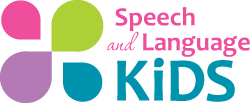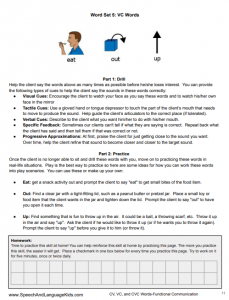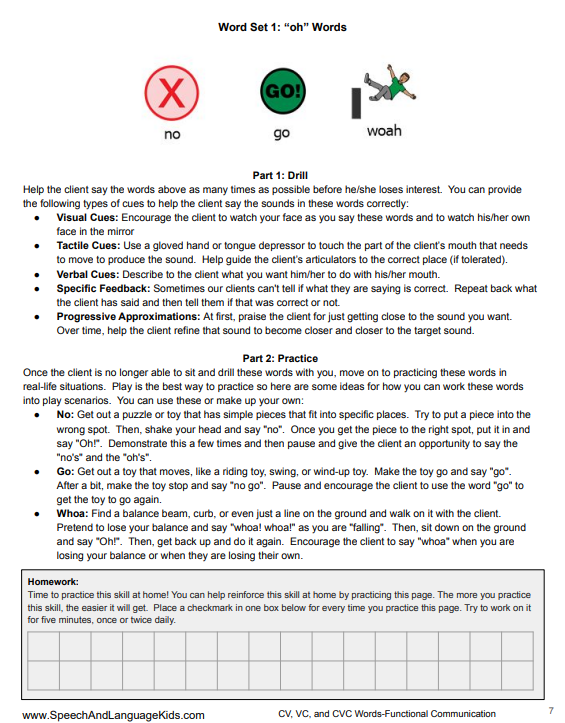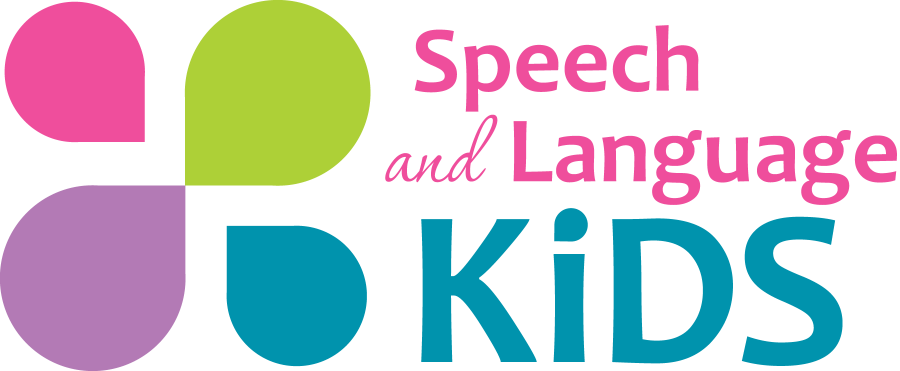CV, VC, CVC, and CVCV Words: Speech Therapy Materials
Children who are learning to speak or learning to read can benefit from practicing with shorter words first, such as:
- Consonant-Vowel (CV) Words
- Vowel-Consonant (VC) Words
- Consonant-Vowel-Consonant (CVC) Words
- Consonant-Vowel-Consonant-Vowel (CVCV) Words
This page contains lists of CV, VC, CVC, and CVCV words and explains how to use those words in speech therapy to help a child learn to speak and communicate their basic wants and needs.
How and Why to Use CV, VC, CVC, and CVCV Words in Speech Therapy:
When working with a child who is not able to speak long words, we can begin improving their speech by teaching them to produce sounds in CV, VC, CVC, and CVCV words.
These are short words that combine just a few vowels and consonants together in a way that make those words easier to say.
For example, “eat” is an example of a “vowel-consonant” word because when you say it, you only say the “ee” sound and the /t/ sound.
All of the words on this page are specifically for use in speech sound therapy, so the combinations of consonants and vowels will be based on how the word sounds, not how it is spelled.
Consonant-Vowel (CV) Words List:
- me
- key
- knee
- shoe
- no
- cow
- boy
- bee
- paw
- saw
- toe
- tie
- you
- bow
- hay
- pie
- go
Vowel-Consonant (VC) Word List:
- up
- arm
- eat
- egg
- ice
- out
Consonant-Vowel-Consonant (CVC) Word List:
- moon
- hat
- goose
- fan
- mouse
- coat
- comb
- cup
- dice
- boot
- bus
- cake
- cat
- bed
- tape
- bike
- book
- wave
- fish
- five
- mouth
- dog
- duck
- face
- foot
- leaf
- leg
- nose
- light
- hose
- kite
- knife
- lake
- gas
- gum
- white
- house
- sock
- pig
- nine
- food
- lime
- one
- soap
- phone
Consonant-Vowel-Consonant-Vowel (CVCV) Word List:
- baby
- bunny
- taco
- coffee
- cookie
- heavy
- hammer
- hippo
- honey
- ladder
- lady
- lego
- yo-yo
- money
- over
- paper
- penny
- pillow
- puppy
- pony
Who Benefits from Using CV, VC, CVC Words in Speech Therapy?
The children who would benefit most from using these decks of cards are children who have multiple speech errors and have difficulty putting together simple words such as these.
For example, children with apraxia of speech, autism, Down Syndrome, and severe phonological processes are all good fits for these cards as long as they are still working on putting together sounds to form simple words.
If the child is difficult to understand and you’re not sure why, these cards are a good place to start. You can always move to more difficult words later when the child is ready.
How to Use CV, VC, CVC, CVCV Words in Speech Therapy:
- Download the No-Prep Curriculum Above: Start your free trial to access our CV, VC, CVC Words Curriculum
- Select a Page: Each page features different CV, VC, or CVC Words. Choose one to start that you think the child will be most interested in.
- Model the Words: Model the words using the cues provided on the page
- Practice: Use the play activities provided on each page to work those words into fun, interactive activities. Use the strategies provided to encourage the child to imitate you.
How to Make CV, VC, CVC Word Practice Fun!
You can entice the child to want to work on speech sounds by making it fun! Try some of these ideas below, or check out our post about how to make speech practice more fun.
- Play a game while you work
- Trace something while you work
- Give them a piece to something after they do a little work (like a piece to a marble run)
- Hold yoga poses while doing work
- Perform actions while doing work (can you say your word while hopping on one foot?)
- Shoot hoops or toss a ball while doing work
- Plastic coins/treasure in a slot for each word
- Put the picture cards in mailbox after you say them
- Find computer or I-Pad games that will work on the skill (like Articulation Station!)
- Have the child be the teacher and show you how to do it (get it wrong so they can correct you)
- Hide their words around the house and have them find the words
- Video tape or audio record them doing their words so they can watch/listen to it later
- Take pictures of them doing their words and make a book they can show others
- Tape words to walls in the bathroom, turn off lights, use flashlight to find and say them
- Put words on wall and shoot them with a dart gun, then say the word you shot
- Praise them a lot!!
- End with something they are successful with
- If it’s too hard, back down to something easier and then mix in the harder ones
- If you get frustrated, end the session early.
- Mark their progress and show it to them, like on a chart or graph
If the Child isn’t Able to Imitate These Words:
If the child won’t imitate any words yet, start by having him imitate actions and then work up to having him imitate sounds that you make with the mouth. This might be a better place to start for some children. If he won’t imitate actions, help him do the action after you and then praise him or give him a reinforcement that he really likes, like a favorite toy or food. Use the first phases of this Curriculum to work on improving imitation.

About the Author: Carrie Clark, MA CCC-SLP
Hi, I’m Carrie! I’m a speech-language pathologist from Columbia, Missouri, USA. I’ve worked with children and teenagers of all ages in schools, preschools, and even my own private practice. I love digging through the research on speech and language topics and breaking it down into step-by-step plans for my followers.
Fun Fact: My favorite animal is the sloth. They are so darn cute and I often feel like my brain and body are moving too much and in those moments, I try hard to channel my inner sloth and slow it down. I always feel better when I’m focusing on bringing some sloth mode into my day.
Connect with Me:





YOU ARE FANTASTIC !!! Many thanks !!!
No you’re fantastic! 🙂 Thanks for reading!
Dear Carrie, thank you so much for your wonderful article!
Could you please send us the cards?
Sincerely,
Inna
Hi, Inna-We just emailed you the requested materials. Please let us know if we can be of any further help.
how do I print the free printable cards, or if possible could you send me the cards via email to my personal email: mgeemorea1986@gmail.com… thank you for your time and appreciate you, God bless you
How do I download free printable cards?
There should be a button that says download. If not, please email me at Carrie@Speechandlanguagekids.com and I will email it to you directly.
Pls I will like to get the printable cards, kindly send to me on this email annebassey52@gmail.com
Hi, Anne-We’ve emailed you a copy of the requested resource. Please let us know if you need anything further.
Hi please send me the link to download. Thank you
Hi, Divinah-We have emailed you a copy of the requested resource. Please let us know if you need anything further.
I need the transcriptions of the words listed
Hi, Olivia-
I have sent the requested resource to you. Please check your inbox when you get the chance.
Can I get a picture copy of these?
Hi, Dana-
You sure can! Just click here.
Please send me the link to download the pictures for this CVC and CVVC package.
I just sent them to your email address!
Please send me the link to download free CVC cards.
Thanks,
Sue Wolff
Ok, I just sent you an email. Let me know if you don’t get it!
Please can you send me a link so I can download the CV VC worksheets? Many thanks
I just emailed it to you! Let me know if you don’t get it
Hi, I’d love a copy of your CVC and CVCV artic visuals please.
Thanks!
Ok, I just sent them to your email. Let me know if you don’t get them!
Carrie,
Is there something special to do to get the download? I’d love to have them for my students.
Thanks!
If you can’t access it on your computer, try a different browser or try using a home computer or cell phone. For some reason, some school networks block my downloads. If you’re still having trouble, send me an email and I’ll send it to you directly.
Hello I would love a copy of your CV, VC, CVC and CVCV artic visuals please.
Thanks!
Lisa
I just emailed it to you. Let me know if you don’t get it!
The pictures for the VC, VC, CVC and CVCV cards look great. They would be a great asset for helping my preschoolers struggling with apraxia and phonological processes. How do I go about downloading them?
Thanks so much for all your work!!
Jenny
Jenny, you should see a download button somewhere on the page. If not, it may be getting blocked by your school network. Try downloading at home or just email me and I’ll send them over to you: carrie@speechandlanguagekids.com
extremely good work… thanks a lot for making this reachable …:)
Absolutely! Glad you enjoyed it!
Hello,
I would like to get a copy of your CV,VC,CVC,CVCV please..
Lot of thanks..
April
No problem! Just send me an email at Carrie@Speechandlanguagekids.com and we’ll send that right over!
Thanks so much for making these accessible! Nice work!
You’re welcome!!
I want to subscribe to your youtube page but it doesnt allow me to do so. If I subcribe to your page can i also get my free ebook offer?
Shoot me an email and I will send you the eBook. Email me at Carrie@SpeechAndLanguageKids.com and ask for the “Operation: Better Speech” eBook!
Hello! Can I get a copy of this.
Thank you,
Hi! Sure thing! Just email me at Carrie@SpeechAndlanguageKids.com and let us know exactly which one(s) you’re trying to get!
Carrie@SpeechAndlanguageKids.com pls send me a copy of your cvc/cvcc package
thank you so much
No problem! Just send me an email directly at Carrie@speechandlanguagekids.com and we’ll get it sent over.
Please send me the link for the free CV VC CVC and CVCV pictures. Thank you.
Hi! Please email me at carrie@speechandlanguagekids.com and we’ll get you taken care of!
Hi Carrie,
Can you please send me the free CV, VC, CVC, CVCV package of picture cards?
Thank you very much!
No problem! Just email me at Carrie@Speechandlanguagekids.com and let my assistant know which worksheet(s) you need.
hi noting is download free here
Email me at Carrie@Speechandlanguagekids.com and we’ll make sure you get what you need.
I would love your free CV, VC, CVC, CVCV package of picture cards. Could I have them? Thanks!
Please email me at Carrie@Speechandlanguagekids.com
Thank you for your effort in putting together such a vast resource for fellow SLPs. You make a true difference!
You’re welcome!
Hi Ms. Carie, I’d like to have your free CV, VC, CVC, CVCV package of pictures please.
Please email me at Carrie@SpeechAndLanguageKids.com and we’ll get you set up
I m impresssssss and i want to thank for understand me this syllable structure
No problem!
Thanks a lot . You are great. Thanks again.
Thank you!!
please send me a link for the cards
No problem! Email me at Carrie@Speechandlanguagekids.com and my assistant will send them over.
I can’t get the link to work, can I get them emailed to me still?
Sure! Email us at Carrie@Speechandlanguagekids.com
Hi ma’am Carrie… I am so glad I found you… Thank you for sharing this. God bless you more..
Cant download pls help i want to print it t thank you
Cassia-
In case you still needed those articulation cards, please use this link.
I’d love a set please!
Hi, Nina-
If you still need a set of these articulation cards, you can click this link to access/download them.
pleaser send me a copy at mano_fati@hotmail.com
thanks
Hi, Fatima-
The requested materials have been emailed to you. If you do not receive them, please email us at speechandlanguagekids@gmail.com with an alternate email address and we’d be more than happy to resend them out!
Can you send me an email with the materials please . thank you
Hi, Amanda-
We have emailed you the requested materials. If you do not receive them, please email us at speechandlanguagekids@gmail.com and we’ll resend them to you.
I need the cards, can you please send me the link
thank you
Hi, Diana-
The requested materials have been sent via email to you. Please let me know if you need anything else.
I would love to have the freebies!!
Thanks a million
Zohreh.mcs@gmail.com
Hi, Zohreh-
I have emailed you the articulation cards.
I really enjoyed watching your videos however, I could not get the links to work. Are they still available?
Hi, Candace-
The articulation cards have been emailed to you. Please let us know if you need anything else.
Hello! Are these cards still available?! Would love to receive a copy of these. They will be very helpful in my daily work routine!
Hi, Jennifer-
I’ve emailed you the articulation cards. If do not receive them, please email us directly at speechandlanguagekids@gmail.com.
Hi please email me this Angel.lampa@yahoo.com thank you!
Hi, Angel-
I have emailed these cards over to you.
Hi..Please share a copy of these cards.. Thanks
Hi, Sushma-
An email has been sent with the requested materials.
Hi Kena, this is amazing! Are you still offering as a free resource? If so, please share a copy of cards with me
Plz send me whole package regarding speech n language therapies for printing ..
Hello,
I would love to have these cards, send them my way please!
Hi, Kia-
Here is the link for the cards.
~Kena
Hi! Please share the link.
Thanks!
Hi, Sandy-
Here is the link for the CV, VC cards. Please let us know if you need anything else.
~Kena
Hello! please I will need the cards as well. the CVC word card with pictures
Hi, Ummu-
Here is a link to the CV, VC, CVC, CVCV cards you were looking for.
Hi, could I please get copy of cards? Thanks! Appreciate it
Hi, Amanda-
Here is a link for the cards.
I am a daycare provider to a 3 yo with a speech delay, trying to provide support – especially when she doesn’t have speech in summer. thank you so much for the materials AND instruction!
Hi, Melissa-
Here is a link for those cards.
Please send me a copy of these materials.. I really need this for my son with developmental language delay
Hi, Hajielyn-
We have emailed you the requested materials. If you need anything else, please don’t hesitate to email us at speechandlanguagekids@gmail.com.
Hi,
Please email me these materials. I didn’t receive the email after I requested.
Thanks!!
Hey, we really need these CV, VC, and CVC cards. My son is kind of STARTING to use these sounds at school so I need to work with him at home. We have an IEP tomorrow and I’d like to have them with me to show that I will he working along with them and it’d be great for IEP team to see something from your website that they may be interested for their classes. But, are they free for me to download? Were on very limited income, and I try my best to give my boy all he needs to thrive in his ASD, I’m on my phone, clicked the button for the cards but it asked for Payment. Can you help?
Hi, Hannah-Those resources are free. You shouldn’t have to pay anything for them. I’m wondering if you clicked on our membership sign up by mistake. At any rate, I have just emailed you a copy of the materials you requested. Please let me know if you need anything further.
These are remarkable. Very helpful for a new slp graduate to work on
Thanks for the honest feedback, Sidra!
Love all those materials and valuable information.
Thanks, Jessica! We really appreciate the honest feedback!
Thank you Carrie. I am just beginning this process with my little grandchild and am really positive and excited that she will succeed learning to talk. We have the greatest bond for chatting and playing.
What wonderful news, Lise! Please let us know if we can be of further help to you.
Thank you so much
You are more than welcome! Please let us know if you have any questions.
send it too please to me…mercy.macalisang001@deped.gov.ph
Hi, Mercy-We have emailed you a copy of the requested materials. Please let us know if you need anything further.
Hi! Can i have a copy of materials?this will be of great help to my son…thank you..
Hi, Nancy-We have emailed you a copy of the requested resource. Please be in touch shall you need anything further.
World require a copy of the materials for my 4 year old child. Thanks in advance.
Hi, Priti- We have emailed you a copy of the requested resource. Please be in touch shall you need anything further.
please give me a cvc!
Hi, Danny-Please check your inbox. We have emailed you a copy of the requested resource.
Please I can’t download this, can I get it in my email ? amadipromiseo@gmail.com
Hi, Promise-Please check your inbox when you get a change. We have a copy of the requested materials.
Please can you send me a link so I can download the CV VC worksheets? Many thanks
Hi, Neelam-Please check your inbox for the requested materials.
thank u soo much carrie ,u r fantastic <3 , could u plz email me Better Speech” eBook at slpmadiha@gmail.com
Hi, Dr. Madeeha-We have emailed you the requested resource. Please let us know if you need anything further.
This is fantastic could I please have the cards.
Hi, Layla-We have sent a copy of the requested resource to your inbox. Please let us know if you need anything else.
HELLO I WISH I COULD HAVE THE CARDS PLEASE
Hi, Fernanda-We have emailed you a copy of the requested resource. Please be in touch if you need anything else.